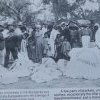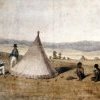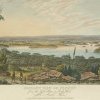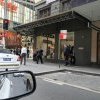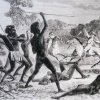1850s
1850
Koori people, perhaps raising funds from locals and tourists, spear fish in Camp Cove with a ‘flaming torch and a four pronged spear’. The British visitor George Fife Angas calls this ‘a lively and a romantic effect’. He remarks that many rock carvings remain unobserved and that they are the remains of ‘a people who are now nearly extinct’.
1851
The colonial visitor Angas often catches a steamboat from Circular Quay to the North Shore and writes, ‘One is soon transported to the secluded and picturesque scenery on the opposite shore, where the pathways leading through the bush are garnished with wild flowers, and the hills may be said to resemble, at this time of the year, one vast flower-garden.’
1852
1854
1855
1856
Anthony Martin Fernando is born at the Wooloomooloo town camp to an Aboriginal mother and possibly an Indian or Sri Lankan father named Silva. Throughout his life he fights against racism directed at Aboriginal and other British Empire Indigenous peoples. He later writes, ‘I was taken from my tribe before I was old enough to remember my mother, but the thought of my mother is the guiding stat of my life’. (Paisley, forthcoming)











